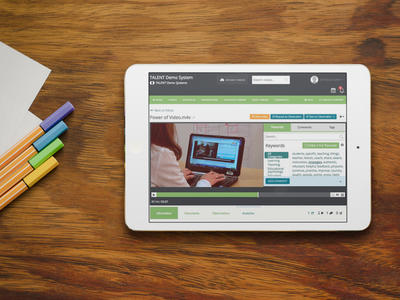This week, we are covering implementation. Our account management team has experience working with more than a hundred clients. Their chief objective is to ensure that video is integrated with your school professional development (PD) seamlessly. Here are their 12 steps to a successful video implementation.
Step 1: Build your team
Step one is establishing a Video Team of staff members who will take the lead on this project.
There are three main roles needed: the Champion, the Professional Development Liaison, and the Daily Administrator. These three roles are vital to ensure that your school or organization is successful in integrating video into your PD plan.
The Champion: champions the project, creates an implementation plan and sets the overall vision and goals.
The Professional Development Liaison: ensures that the video project goals and implementation plan are successfully integrated with the overall PD goals of the school or organization.
The Daily Administrator: manages the day to day tasks of the project including training, technology issues, general video platform management and communication with the video technology provider.
Understandably, based on the size and needs of your school or organization, three separate people may not be possible. If one person takes on the responsibility, their role should span all three critical areas.
Step 2: Integrate PD into video plans
With the lead of the Professional Development Liaison, the Video Team should ensure that video is fully integrated with the school’s or organization’s current coaching and PD strategies.
Video is best used in conjunction with current strategies and not as an additional task. Torsh TALENT is a high-quality video platform that provides custom integration with schools or organizations online portals or Learning Management Systems (e.g. Blackboard, Canvas, Sakai, etc.). This integration allows schools or organizations to seamlessly incorporate video into current work rather than adding another online system to log into and use.
Step 3: Take advantage of the onboarding webinar
TALENT provides an initial onboarding training session for the Video Team. Take advantage of this valuable training opportunity.
During these onboarding sessions, the main focus is for the account team to get a better sense of the school or organization’s goals and main video needs. This allows us to best support the school or organization during the implementation process. It is also a great venue for the Video Team to bring up questions or concerns and set up a plan to manage technology issues, initiate a general user training, and talk through available ongoing support.
Step 4: Review all help resources
When a school or organization first starts using a new video platform, it is important to learn as much as possible about the system.
The Video Team should have a very clear understanding of how to use the new platform. We provide numerous resources in various formats to ensure that users can get the help and support they need. Some important resources to review are our Getting Started Documents, Help Video Tutorials, and FAQs. The Video Team and especially, the Daily Administrator, should peruse these resources and make sure they have an intimate knowledge of the system overall. The Video Team should think through the best plan for distributing these resources whether it be through posting them on their own website, sending out emails, or including information in newsletters.
Step 5: Introduce video to leadership
One main responsibility of the Champion is to introduce video to all leadership staff at the school or organization.
It is most important to generate initial leadership buy-in and support for video coaching and feedback. The Champion should showcase a clear need and relevant goals for video in order to help impress upon leadership the value of video in professional development efforts. It may also be valuable to demo the video platform to leadership staff. The more that leadership supports the integration of video into PD, the more likely the school or organization will have a successful implementation.
Step 6: Decide on a plan for video capture equipment
A vital part of a video implementation plan is deciding on the ideal video capture devices and processes for all users.
TALENT provides video uploading applications for most smartphones and tablets to ensure an easy and quick video upload experience. If tablets/smartphones are not an option for your school or organization, any recording device is sufficient. Another consideration is capturing good quality audio and a stable recording. These can be accomplished through the use of an external microphone and a tripod. Check out two of our other resources on Tips for Recording Good Quality Video and Video Capture Equipment Recommendations for more information on video best practices.
Step 7: Educate all coaches on the video platform
All coaches using video should have a clear understanding of and comfort level using the platform.
The Daily Administrator should onboard all coaches to the system, make sure they are competent using the technology, and ensure that they understand the goals and plans for using the video platform for PD. The coaches will need to be the first line of technical support for teachers. Therefore, prior to introducing video to teachers, all coaches and leadership staff should have general knowledge of the video platform, plans for implementation, and should work to improve their knowledge base on an ongoing basis.
Step 8: Introduce video to teachers
Once all leadership staff and coaches are onboarded to the video platform, it is now time to introduce video to the general user population at your school or organization.
For most schools and organizations, the general population is teachers. It is important that teachers are introduced to video and the video platform before accounts are set up or assignments are given. The process of educating teachers about video and the video platform prior to implementation will greatly support buy-in and understanding. A couple strategies to support teacher education is to start introducing content around using video in PD through email communication and newsletters and through an initial training session, which we will cover in the next step.
Step 9: Host an initial training session
It’s also a good idea to set up an initial video training for teachers.
It is important to designate one training session exclusively for video and the video platform. An intensive initial training process supports users through the initial learning curve that is customary when introducing any new system. This is especially important if your teachers are not familiar or comfortable with using technology in their daily practice. Setting them up with a strong foundation and knowledge of the video platform will set them up for success. In addition to going over the “What?” and “How to’s,” it is important to make sure teachers understand where to find support and help resources, and whom they can contact for technical issues and concerns.
Step 10: Ramp up gradually
Using a new system and technology with the whole or even just part of a school or organization comes with a learning curve for all.
This is why it’s helpful to start the general user off with simple video-related activities and assignments to introduce them to the new experience of video and the video platform. Teachers must first become comfortable with using video and specifically using video in their PD work before they can fully take advantage of the new technology. One recommended strategy is to start off users with an initial practice exercise, such as simply uploading a video of their choice onto the new platform, sharing that video with a colleague, and beginning to use the annotation features available. This is a good way to introduce users to the basic features of the new platform and get them comfortable with everyday video activities.
Step 11: Generate teacher buy-in for video
It is just as important to generate buy-in with teachers as it is with leadership.
There are numerous strategies to create buy-in, and depending on the school or organization, different strategies may work better than others. One strategy that some of our customers have used successfully is adding incentives, such as professional development credit, to all teachers who upload videos and begin to use videos in their practice. If teachers see video as an additional task to complete on top of all their other responsibilities, they are less likely to actively participate. Incentives help build up teachers’ desire to use video and limit the feeling of video being another task on their plate. Additionally, self-selection of videos allows teachers to have greater self-efficacy and agency in the sharing, coaching, and observation process. Giving teachers the option to record and upload their own videos allows teachers additional control. This control helps create the conditions needed for greater safety and trust in the coaching and feedback processes.
Step 12: Provide easily accessible support
All teachers should have access to multiple lines of support, especially in the beginning when they first start using video and the new video platform for PD.
Everyone should have knowledge of who they can contact for support (i.e. The Daily Administrator, Coaches, and the video platform’s customer support) with video in general and any technical issues. In addition, everyone should understand and have access to all available help resources.
We hope you found these 12 steps helpful! As always, if you have questions about implementation or need additional support, you can always reach out to your account manager or the support team at support@torsh.co!




